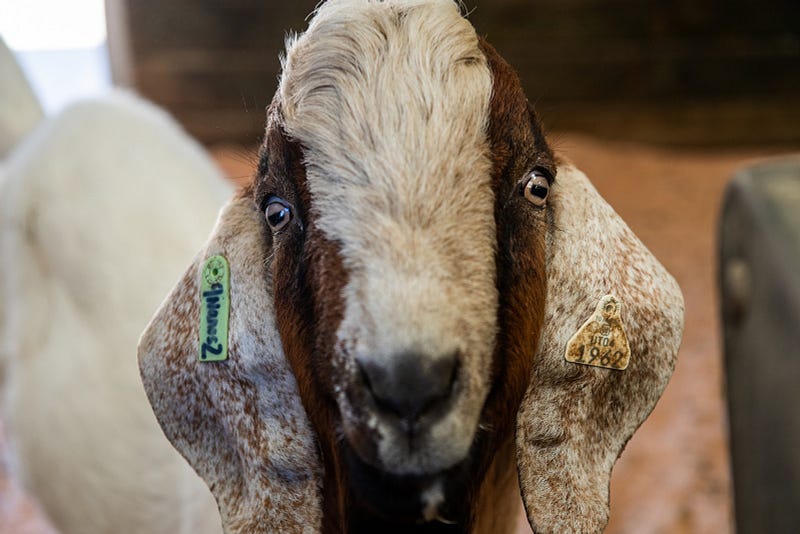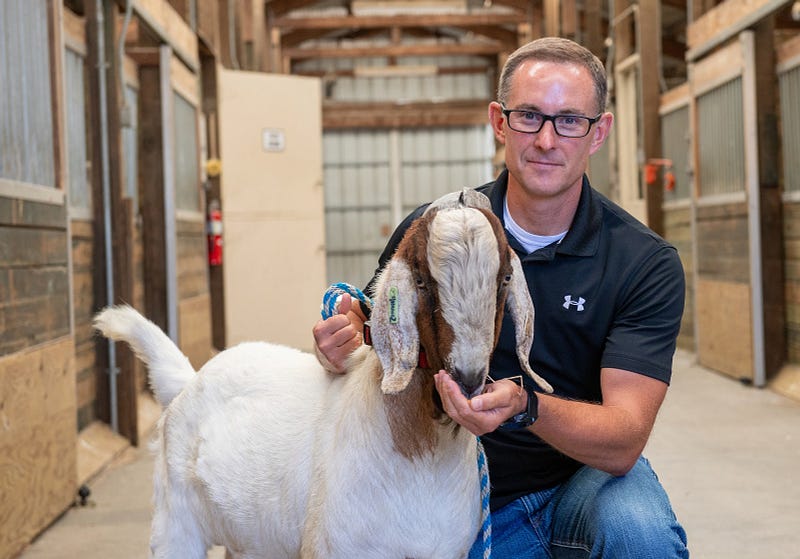Innovative "Super Daddy" Goats Could Help Livestock Adapt to Climate Change
Written on
In a laboratory barn in Pullman, Washington, goat #1962 has a singular mission: to reproduce. This goat represents the pioneering generation of gene-edited "Super Daddy" or "Surrogate Sire" goats, capable of transmitting not their own, but the superior DNA of another buck.
Jon Oatley, PhD, a reproductive biologist leading this project, has dedicated two decades to this vision. He asserts that surrogate sires will be vital in breeding livestock that yield more meat, dairy, and fiber while enduring the challenges posed by climate change.
“As climate shifts and populations expand, we require animals to achieve more with less,” Oatley explains to Future Human. “Genetic modifications represent a fundamental variable influencing how effectively animals convert resources into outputs.”
In a recent study featured in the Proceedings of the National Academy of Science, Oatley and his team detail a two-step process for creating surrogate sires. Initially, the CRISPR gene-editing tool is employed to produce sterile male goats, pigs, and cattle. Subsequently, stem cells from a different male of the same species are implanted into their testicles, allowing them to convey the genetics of another male. This six-year research initiative is a collaborative effort involving experts from WSU, Utah State University, the University of Maryland, and the Roslin Institute at the University of Edinburgh.
The surrogate sires project is designed as a swift response mechanism to generate climate-resilient livestock efficiently. Consider the Nelore cattle breed, for instance.
This robust breed features loose, thick black skin and white hair that reflects sunlight, making it the most favored cattle breed in Brazil due to its resilience against heat and insects. While the Nelore produces less meat than the popular Aberdeen Angus breed in the U.S., it thrives in harsh Brazilian climates, unlike the Angus.
Imagine a gene-edited Nelore bull with Angus semen. Placing him in a herd of Nelore females could yield numerous crossbred offspring without the stress an Angus bull would face in Brazil. Ranchers could then select the most productive, climate-adapted cows from this initial generation for future breeding, effectively developing a new breed that flourishes in South America while providing substantial meat yields.
Oatley highlights the transformative potential of surrogate sires. Once established, they can facilitate genetic enhancements in a straightforward manner. All these "super daddies" need to do is what comes naturally: reproduce.

Challenges with Subpar Genetics in Developing Nations
According to Steve Kemp, PhD, a professor at the University of Edinburgh, livestock in developing countries has been “selected for survival, but not much else.” Currently based in Kenya, Kemp leads livestock genetics programs at the International Livestock Research Institute (ILRI), focused on enhancing food security and nutrition through improved livestock practices.
Animals are essential for human survival amid climate change, especially in developing regions where vulnerable populations rely on livestock in areas unsuitable for crop cultivation. The Food and Agriculture Organization of the United Nations reports that 60% of global agricultural land isn't suitable for crops but can support livestock. Animals exhibit greater resilience to climate shocks than crops, as they can be relocated during extreme weather events, unlike static crops.
Globally, at least 1.3 billion people depend on livestock for their livelihoods. However, climate-related disasters resulted in a 36% decrease in livestock productivity between 2006 and 2016. This trend could spiral into increased food insecurity and malnutrition, especially with an anticipated 2 billion additional people on the planet in the next 30 years. Feeding and clothing the world's most vulnerable populations will increasingly hinge on livestock production, with an expected 72% rise in meat production by 2030 compared to 1999 levels.
Yet, increased livestock comes with a downside: more greenhouse gas emissions. Currently, livestock accounts for 14.5% of global greenhouse gas emissions. The demand for more meat in the face of climate change may ironically exacerbate climate challenges, necessitating not just more livestock, but improved livestock.
Developed countries have made strides in this area. In the U.S., livestock contributes only 4% to total greenhouse gas emissions, partly due to significant reductions in herd sizes while production of meat and milk has increased through selective breeding.
Unfortunately, these breeding techniques have often failed in developing nations. “The history of animal breeding in Africa is riddled with failures,” Kemp notes. “Various attempts to introduce breeding expertise have repeatedly fallen short of establishing sustainable practices.”
A typical cow in the developing world may produce one to four liters of milk daily, a mere fraction of what an average dairy cow produces in developed countries. Beef and egg production in developed nations has consistently improved, while developing regions lag behind.
Kemp points out, “In East Africa, for instance, there’s a noticeable lack of progress in productivity metrics.” While subpar genetics play a significant role, other factors such as housing conditions, veterinary care, and nutrition also contribute to lower output. Smallholders, who produce about 80% of food in Asia and sub-Saharan Africa, often find themselves trapped in a cycle of unproductive, unhealthy livestock. Breaking this cycle hinges on improving genetics, as “without potential, feeding them better won’t matter.”
One major hurdle in enhancing genetics is the supply chain—specifically, ensuring that the right sperm reaches the right female at the optimal time.
Artificial insemination (A.I.) is a common method of obtaining elite genetics through semen collection from superior males and breeding with females. A.I. has significantly improved livestock performance, particularly in the U.S. dairy sector.
To perform A.I., semen is collected from a male using an artificial vagina, which provides warmth and stimulation to induce ejaculation. In developed countries, elite bulls are housed specifically for semen collection, freezing, and distribution.
Once harvested, semen is stored in straws and kept in liquid nitrogen until a female in heat is ready for insemination. Most livestock breeding must occur within a narrow 12-hour window during ovulation. Many U.S. dairy farmers are trained to perform their own A.I., while others hire local technicians.
However, in developing nations like Africa, the A.I. process faces numerous challenges. Farmers may miss heat cycles if they don’t monitor their animals closely or keep detailed records. Centralized semen collection services are often lacking, and A.I. technicians face obstacles such as poor roads and high temperatures while preserving the cold chain for the semen. Consequently, many A.I. attempts fail, leading to financial losses for farmers.
Moreover, A.I. has not been widely employed for small ruminants, which are more crucial for smallholders in developing countries. The procedure is more invasive and requires skilled technicians, complicating the detection of heat cycles in goats and sheep compared to cattle.
ILRI has established community-based breeding initiatives for goats and sheep, encouraging farmers to collaborate and share their best animals to enhance local herds. While effective, these improvements are limited by the genetics of surrounding animals. With a surrogate sire program, genetics could be imported from anywhere in the world.
This is why goat #1962 is generating excitement.
“Distributing elite semen into potentially hundreds or thousands of males and sending them out as living, breathing carriers is revolutionary,” Kemp states. “They not only maintain semen quality but also determine precisely when it’s needed and deliver it.”

While U.S. farmers aren't facing such severe productivity crises, the potential for surrogate sires to enhance livestock efficiency remains significant, according to Oatley. They could improve the conversion of feed into meat, dairy, and fiber, which would greatly benefit U.S. agriculture.
“Reducing feed requirements means less land needs to be farmed for animal feed,” he explains.
CRISPR and the Quest for Sterility
The concept of surrogate sires represents a pivotal advancement in livestock reproductive strategies.
Any animal breeder will affirm that elite male genetics have the most substantial impact on herd quality. A single exceptional male can produce hundreds, if not thousands, of offspring annually. While females handle the majority of reproduction, they can only contribute genetics to a limited number of offspring.
Creating surrogate sires necessitates injecting stem cells into sterile males' testicles. If a male remains fertile, it will continue to produce its own sperm instead of the desired elite sperm. Historically, a significant challenge was finding a straightforward method to achieve sterility, as Oatley noted.
Previous attempts to reduce sperm production in mice involved radiation or chemotherapy; however, these methods were not feasible for livestock.
“There are welfare and biohazard concerns,” Oatley points out. “Applying chemotherapy to a 2,000-pound bull? Not practical.”
The breakthrough came with the introduction of the CRISPR-Cas9 gene-editing tool. Oatley and his team successfully eliminated the fertility gene known as NANOS2 in mammals for the first time, resulting in so-called “knockout” males that are otherwise normal but sterile.
After generating sterile males—goat #1962 being one of five born in Oatley’s lab—the team injected donor sperm-producing stem cells into their testicles. As the goat's reproductive system matured, they confirmed that #1962 was capable of producing viable sperm, just not his own.